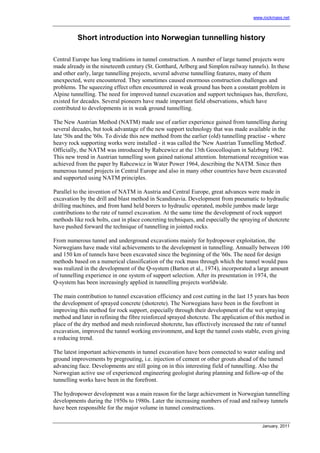Short introduction into norwegian tunnelling history
- 1. www.rockmass.net January, 2011 Short introduction into Norwegian tunnelling history Central Europe has long traditions in tunnel construction. A number of large tunnel projects were made already in the nineteenth century (St. Gotthard, Arlberg and Simplon railway tunnels). In these and other early, large tunnelling projects, several adverse tunnelling features, many of them unexpected, were encountered. They sometimes caused enormous construction challenges and problems. The squeezing effect often encountered in weak ground has been a constant problem in Alpine tunnelling. The need for improved tunnel excavation and support techniques has, therefore, existed for decades. Several pioneers have made important field observations, which have contributed to developments in in weak ground tunnelling. The New Austrian Method (NATM) made use of earlier experience gained from tunnelling during several decades, but took advantage of the new support technology that was made available in the late '50s and the '60s. To divide this new method from the earlier (old) tunnelling practise - where heavy rock supporting works were installed - it was called the 'New Austrian Tunnelling Method'. Officially, the NATM was introduced by Rabcewicz at the 13th Geocolloqium in Salzburg 1962. This new trend in Austrian tunnelling soon gained national attention. International recognition was achieved from the paper by Rabcewicz in Water Power 1964, describing the NATM. Since then numerous tunnel projects in Central Europe and also in many other countries have been excavated and supported using NATM principles. Parallel to the invention of NATM in Austria and Central Europe, great advances were made in excavation by the drill and blast method in Scandinavia. Development from pneumatic to hydraulic drilling machines, and from hand held borers to hydraulic operated, mobile jumbos made large contributions to the rate of tunnel excavation. At the same time the development of rock support methods like rock bolts, cast in place concreting techniques, and especially the spraying of shotcrete have pushed forward the technique of tunnelling in jointed rocks. From numerous tunnel and underground excavations mainly for hydropower exploitation, the Norwegians have made vital achievements to the development in tunnelling. Annually between 100 and 150 km of tunnels have been excavated since the beginning of the '60s. The need for design methods based on a numerical classification of the rock mass through which the tunnel would pass was realized in the development of the Q-system (Barton et al., 1974), incorporated a large amount of tunnelling experience in one system of support selection. After its presentation in 1974, the Q-system has been increasingly applied in tunnelling projects worldwide. The main contribution to tunnel excavation efficiency and cost cutting in the last 15 years has been the development of sprayed concrete (shotcrete). The Norwegians have been in the forefront in improving this method for rock support, especially through their development of the wet spraying method and later in refining the fibre reinforced sprayed shotcrete. The application of this method in place of the dry method and mesh reinforced shotcrete, has effectively increased the rate of tunnel excavation, improved the tunnel working environment, and kept the tunnel costs stable, even giving a reducing trend. The latest important achievements in tunnel excavation have been connected to water sealing and ground improvements by pregrouting, i.e. injection of cement or other grouts ahead of the tunnel advancing face. Developments are still going on in this interesting field of tunnelling. Also the Norwegian active use of experienced engineering geologist during planning and follow-up of the tunnelling works have been in the forefront. The hydropower development was a main reason for the large achievement in Norwegian tunnelling developments during the 1950s to 1980s. Later the increasing numbers of road and railway tunnels have been responsible for the major volume in tunnel constructions.

